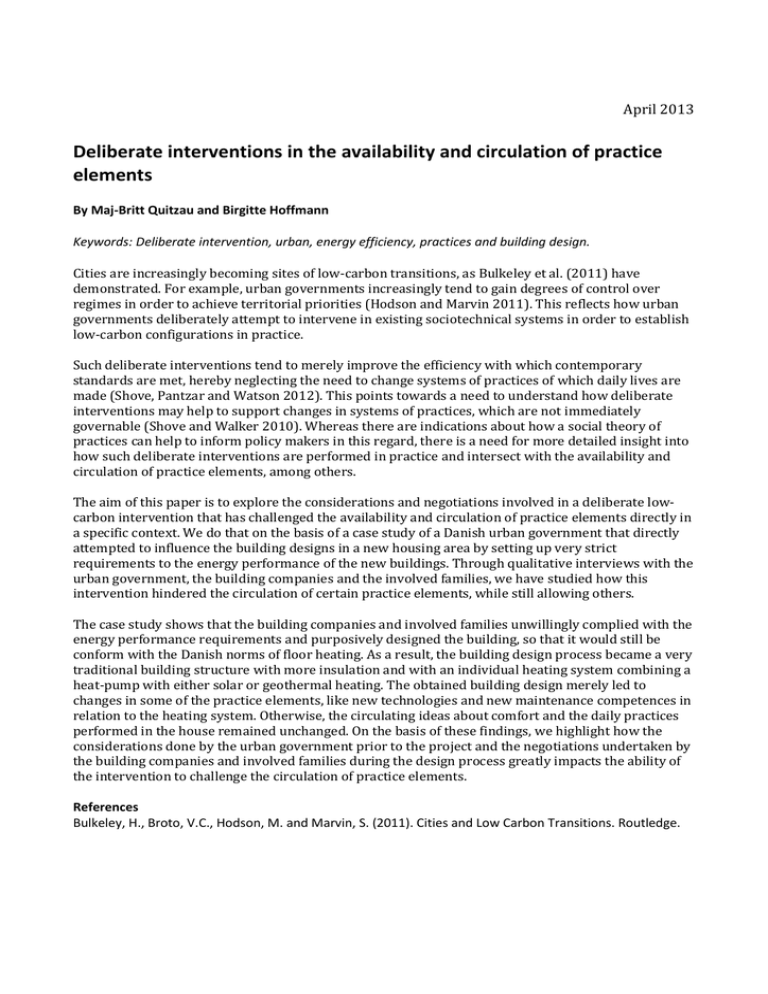187 Quitzau ness abstract WG2
advertisement

April 2013 Deliberate interventions in the availability and circulation of practice elements By Maj-Britt Quitzau and Birgitte Hoffmann Keywords: Deliberate intervention, urban, energy efficiency, practices and building design. Cities are increasingly becoming sites of low-carbon transitions, as Bulkeley et al. (2011) have demonstrated. For example, urban governments increasingly tend to gain degrees of control over regimes in order to achieve territorial priorities (Hodson and Marvin 2011). This reflects how urban governments deliberately attempt to intervene in existing sociotechnical systems in order to establish low-carbon configurations in practice. Such deliberate interventions tend to merely improve the efficiency with which contemporary standards are met, hereby neglecting the need to change systems of practices of which daily lives are made (Shove, Pantzar and Watson 2012). This points towards a need to understand how deliberate interventions may help to support changes in systems of practices, which are not immediately governable (Shove and Walker 2010). Whereas there are indications about how a social theory of practices can help to inform policy makers in this regard, there is a need for more detailed insight into how such deliberate interventions are performed in practice and intersect with the availability and circulation of practice elements, among others. The aim of this paper is to explore the considerations and negotiations involved in a deliberate lowcarbon intervention that has challenged the availability and circulation of practice elements directly in a specific context. We do that on the basis of a case study of a Danish urban government that directly attempted to influence the building designs in a new housing area by setting up very strict requirements to the energy performance of the new buildings. Through qualitative interviews with the urban government, the building companies and the involved families, we have studied how this intervention hindered the circulation of certain practice elements, while still allowing others. The case study shows that the building companies and involved families unwillingly complied with the energy performance requirements and purposively designed the building, so that it would still be conform with the Danish norms of floor heating. As a result, the building design process became a very traditional building structure with more insulation and with an individual heating system combining a heat-pump with either solar or geothermal heating. The obtained building design merely led to changes in some of the practice elements, like new technologies and new maintenance competences in relation to the heating system. Otherwise, the circulating ideas about comfort and the daily practices performed in the house remained unchanged. On the basis of these findings, we highlight how the considerations done by the urban government prior to the project and the negotiations undertaken by the building companies and involved families during the design process greatly impacts the ability of the intervention to challenge the circulation of practice elements. References Bulkeley, H., Broto, V.C., Hodson, M. and Marvin, S. (2011). Cities and Low Carbon Transitions. Routledge. Hodson, M. and Marvin, S. (2011). Can cities shape socio-technical transitions and how would we know if they were? In: Bulkeley, H., Broto, V.C., Hodson, M. and Marvin, S. Cities and Low Carbon Transitions, pp. 54-70. Shove, E., Pantzar, M. and Watson, M. (2012). The Dynamics of Social Practice – Everyday life and how it changes. Sage. Shove, E. and Walker, G. (2010). Governing transitions in the sustainability of everyday life. In: Research Policy 39, pp. 471-476.

